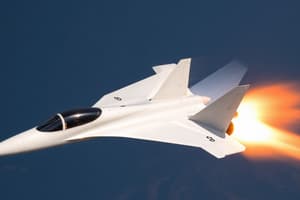Podcast
Questions and Answers
What is a recommended technique for improving understanding of challenging topics?
What is a recommended technique for improving understanding of challenging topics?
- Ignoring difficult topics altogether
- Watching video explanations on the internet (correct)
- Searching for explanations on social media
- Reading textbooks only
Which method is suggested for memorizing formulas that change with conditions?
Which method is suggested for memorizing formulas that change with conditions?
- Memorizing them without context
- Discussing them with classmates
- Rewriting them multiple times
- Creating a table for comparison (correct)
What is intended by the statement 'you may not distribute or commercially exploit the content'?
What is intended by the statement 'you may not distribute or commercially exploit the content'?
- You can share with everyone freely
- You must get permission before using it for profit (correct)
- You can use it for any educational purpose
- You can store it on any website
What should you do after each learning session to reinforce your understanding?
What should you do after each learning session to reinforce your understanding?
Why is it important to learn how to search effectively on the internet?
Why is it important to learn how to search effectively on the internet?
What is one advantage of using YouTube for learning complex aerodynamics concepts?
What is one advantage of using YouTube for learning complex aerodynamics concepts?
What are the copyright restrictions stated for the material?
What are the copyright restrictions stated for the material?
What is mentioned as critical when searching for information online?
What is mentioned as critical when searching for information online?
What condition describes subsonic flow along the nozzle but choked at the throat?
What condition describes subsonic flow along the nozzle but choked at the throat?
Which term refers to a supersonic flow after the throat that is correctly expanded?
Which term refers to a supersonic flow after the throat that is correctly expanded?
In the context of flow in a C-D nozzle, what does 'overexpanded' refer to?
In the context of flow in a C-D nozzle, what does 'overexpanded' refer to?
Which equation best represents the normal shock wave condition related to throat area and Mach number?
Which equation best represents the normal shock wave condition related to throat area and Mach number?
What characterizes 'underexpanded' conditions in a nozzle?
What characterizes 'underexpanded' conditions in a nozzle?
How can flow behavior in a converging-diverging nozzle vary?
How can flow behavior in a converging-diverging nozzle vary?
Which of the following describes the formation of a shock wave inside the nozzle?
Which of the following describes the formation of a shock wave inside the nozzle?
What happens to the flow when it is classified as 'correctly expanded'?
What happens to the flow when it is classified as 'correctly expanded'?
What does the Mach angle depend on?
What does the Mach angle depend on?
Which of the following components is not part of the oblique shock wave?
Which of the following components is not part of the oblique shock wave?
What remains constant across an oblique shock wave?
What remains constant across an oblique shock wave?
What happens as the upstream Mach number increases?
What happens as the upstream Mach number increases?
What determines whether a shock is categorized as weak or strong?
What determines whether a shock is categorized as weak or strong?
Which statement about the normal component of velocity in an oblique shock is accurate?
Which statement about the normal component of velocity in an oblique shock is accurate?
What is the relationship between deflection angle and wave angle in an oblique shock?
What is the relationship between deflection angle and wave angle in an oblique shock?
What is the formula for calculating the Mach angle?
What is the formula for calculating the Mach angle?
What is the formula for calculating the temperature ratio across an oblique shock wave in terms of $M_1$ and $k$?
What is the formula for calculating the temperature ratio across an oblique shock wave in terms of $M_1$ and $k$?
What value is used for $k$ in the calculations of temperature and pressure ratios?
What value is used for $k$ in the calculations of temperature and pressure ratios?
In the formula for Mach number after a shock, what is the value of $M_2$ calculated using when $k = 1.4$?
In the formula for Mach number after a shock, what is the value of $M_2$ calculated using when $k = 1.4$?
What happens to the flow when it encounters a concave corner during supersonic speeds?
What happens to the flow when it encounters a concave corner during supersonic speeds?
Which of the following correctly describes the relationship between Mach numbers and pressure ratios?
Which of the following correctly describes the relationship between Mach numbers and pressure ratios?
What do the terms in the oblique shock wave equations primarily account for?
What do the terms in the oblique shock wave equations primarily account for?
What is the implication of flow reaching supersonic speeds regarding the formation of standing waves?
What is the implication of flow reaching supersonic speeds regarding the formation of standing waves?
In terms of the equations presented, what role does $V$ play in the ratios related to Mach numbers?
In terms of the equations presented, what role does $V$ play in the ratios related to Mach numbers?
What principal feature characterizes the deflection angle and shockwave angle in supersonic aerodynamics?
What principal feature characterizes the deflection angle and shockwave angle in supersonic aerodynamics?
Which equation describes the relationship for the lift coefficient in supersonic flow?
Which equation describes the relationship for the lift coefficient in supersonic flow?
What effect does an increase in altitude have on the speed of sound in the atmosphere?
What effect does an increase in altitude have on the speed of sound in the atmosphere?
What is the critical Mach number?
What is the critical Mach number?
What is the primary purpose of a supercritical airfoil?
What is the primary purpose of a supercritical airfoil?
What formula represents the Prandtl-Meyer function given the Mach number $M_1$?
What formula represents the Prandtl-Meyer function given the Mach number $M_1$?
What happens to the critical Mach number as the angle of attack (AoA) increases?
What happens to the critical Mach number as the angle of attack (AoA) increases?
Which of the following is true regarding the drag coefficient in supersonic flow?
Which of the following is true regarding the drag coefficient in supersonic flow?
Flashcards are hidden until you start studying
Study Notes
Supersonic Aerodynamics Overview
- Supersonic aerodynamics involves airflow around objects moving at speeds greater than the speed of sound (Mach 1).
- Important fluid dynamics concepts include lift, drag, and the behavior of shock waves.
Study Tips for Supersonic Aerodynamics
- Read reference books for in-depth information on aerodynamics.
- Utilize online platforms like YouTube for supplemental learning, focusing on how to search effectively.
- Create comparison tables for formulas that vary based on conditions to enhance understanding and memorization.
- Explaining concepts to others reinforces knowledge retention.
Flow Conditions in Converging-Diverging (C-D) Nozzles
- Condition 1: Subsonic flow along the nozzle.
- Condition 2: Subsonic flow with choking at the throat.
- Condition 3: Supersonic flow after the throat (correctly expanded nozzle).
- Condition 4: Supersonic flow in an overexpanded nozzle.
- Condition 5: Supersonic flow in an underexpanded nozzle.
- Condition 6: Formation of shock waves inside the nozzle.
Key Equations for Supersonic Flow
- Temperature Ratio: [ \frac{T_2}{T_1} = \frac{[2kM_1^2 - (k - 1)][M_1^2 (k - 1) + 2]}{[M_1^2 (k + 1)]^2} ]
- Mach Number behind a shock: [ M_2 = \frac{2}{2kM_1^2 - (k - 1)} ]
- Pressure Ratio: [ \frac{P_2}{P_1} = \frac{2kM_1^2 - (k - 1)}{k + 1} ]
- Velocity Ratio: [ \frac{V_2}{V_1} = \frac{M_1^2 (k - 1) + 2}{M_1^2 (k + 1)} ]
Shock Waves
- Oblique shock waves form when supersonic flow encounters a deflection, such as a concave corner.
- The shock wave has normal and tangential velocity components; the tangential component remains constant across the wave.
Prandtl-Meyer Function
- Describes the expansion of flow around a turning surface in supersonic conditions: [ V(M_1) = \sqrt{\frac{k + 1}{k - 1}} \tan^{-1}(\sqrt{M_1^2 - 1}) - \tan^{-1}(\sqrt{M_1^2 - 1}) ]
Additional Concepts
- Supercritical airfoils delay wave drag in transonic speeds.
- Critical Mach number is the free stream Mach number at which airflow first reaches Mach 1 on the airfoil's surface.
Practical Applications
- Importance of adapting designs for wind tunnels to account for different flow characteristics at subsonic and supersonic speeds.
Studying That Suits You
Use AI to generate personalized quizzes and flashcards to suit your learning preferences.





